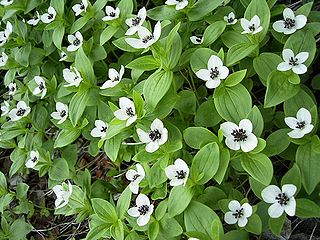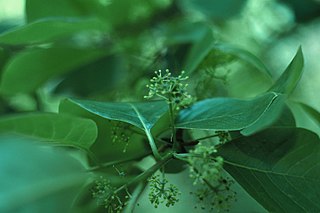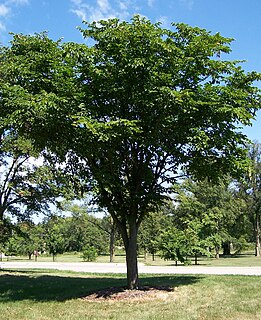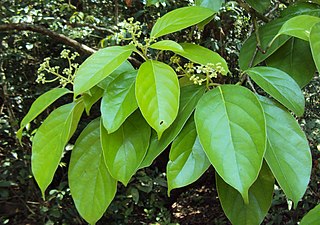
Rosaceae, the rose family, is a medium-sized family of flowering plants that includes 4,828 known species in 91 genera.

The Cornales are an order of flowering plants, early diverging among the asterids, containing about 600 species. Plants within the Cornales usually have four-parted flowers, drupaceous fruits, and inferior to half-inferior gynoecia topped with disc-shaped nectaries.

The Nymphaeales are an order of flowering plants, consisting of three families of aquatic plants, the Hydatellaceae, the Cabombaceae, and the Nymphaeaceae. It is one of the three orders of basal angiosperms, an early-diverging grade of flowering plants. At least 10 morphological characters unite the Nymphaeales. Molecular synapomorphies are also known.

Cornaceae is a cosmopolitan family of flowering plants in the order Cornales. It contains approximately 85 species in two genera, Alangium and Cornus. They are mostly trees and shrubs, which may be deciduous or evergreen, although a few species are perennial herbs. Members of the family usually have opposite or alternate simple leaves, four- or five-parted flowers clustered in inflorescences or pseudanthia, and drupaceous fruits. The family is primarily distributed in northern temperate regions and tropical Asia. In northern temperate areas, Cornaceae are well known from the dogwoods Cornus.

Tupelo, genus Nyssa, is a small genus of deciduous trees with alternate, simple leaves. It is sometimes included in the subfamily Nyssoideae of the dogwood family, Cornaceae, but is placed by other authorities in the family Nyssaceae. In the APG IV system, it is placed in Nyssaceae.

Cornus is a genus of about 30–60 species of woody plants in the family Cornaceae, commonly known as dogwoods, which can generally be distinguished by their blossoms, berries, and distinctive bark. Most are deciduous trees or shrubs, but a few species are nearly herbaceous perennial subshrubs, and a few of the woody species are evergreen. Several species have small heads of inconspicuous flowers surrounded by an involucre of large, typically white petal-like bracts, while others have more open clusters of petal-bearing flowers. The various species of dogwood are native throughout much of temperate and boreal Eurasia and North America, with China, Japan, and the southeastern United States being particularly rich in native species.

The Casuarinaceae are a family of dicotyledonous flowering plants placed in the order Fagales, consisting of four genera and 91 species of trees and shrubs native to eastern Africa, Australia, Southeast Asia, Malesia, Papuasia, and the Pacific Islands. At one time, all species were placed in the genus Casuarina. Lawrence Alexander Sidney Johnson separated out many of those species and renamed them into the new genera of Gymnostoma in 1980 and 1982, Allocasuarina in 1982, and Ceuthostoma in 1988, with some additional formal descriptions of new species in each other genus. At the time, it was somewhat controversial. The monophyly of these genera was later supported in a 2003 genetics study of the family. In the Wettstein system, this family was the only one placed in the order Verticillatae. Likewise, in the Engler, Cronquist, and Kubitzki systems, the Casuarinaceae were the only family placed in the order Casuarinales.

The Ulmaceae are a family of flowering plants that includes the elms, and the zelkovas. Members of the family are widely distributed throughout the north temperate zone, and have a scattered distribution elsewhere except for Australasia.

Hamamelidaceae, commonly referred to as the witch-hazel family, is a family of flowering plants in the order Saxifragales. The clade consists of shrubs and small trees positioned within the woody clade of the core Saxifragales. An earlier system, the Cronquist system, recognized Hamamelidaceae in the Hamamelidales order.

Nyssaceae is a family of flowering trees sometimes included in the dogwood family (Cornaceae). Nyssaceae is composed of 37 known species in the following five genera:

Osmunda is a genus of primarily temperate-zone ferns of family Osmundaceae. Five to ten species have been listed for this genus.
Xanthocyparis is a genus of cypresses in the family Cupressaceae. As of August 2021, it has only one species, Xanthocyparis vietnamensis, native to Vietnam and southeast China. It is commonly known as the Vietnamese golden cypress. The Nootka cypress, Cupressus nootkatensis or Callitropsis nootkatensis, was also placed in the genus, but this has been rejected.

Diapensiaceae is a small family of flowering plants, which includes 15 species in 6 genera. The genera include Berneuxia Decne., Diapensia L., Galax Sims, Pyxidanthera Michx., Shortia Torr. & A.Gray, and Schizocodon Siebold & Zucc.. Members of this family have little economic importance; however, some members are cultivated by florists.

Alangium is a small genus of flowering plants. The genus is included either in a broad view of the dogwood family Cornaceae, or as the sole member of its own family Alangiaceae. Alangium has about 40 species, but some of the species boundaries are not entirely clear. The type species for Alangium is Alangium decapetalum, which is now treated as a subspecies of Alangium salviifolium. All of the species are shrubs or small trees, except the liana Alangium kwangsiense. A. chinense, A. platanifolium, and A. salviifolium are known in cultivation.

The genus Helwingia consists of shrubs or rarely small trees native to eastern Asia, the Himalayas, and northern Indochina. It is the only genus in the family Helwingiaceae.

Mastixia is a genus of about 19 species of resinous evergreen trees, usually placed in the family Cornaceae. Its range extends from India through Southeast Asia and New Guinea to the Solomon Islands. Mastixia species have alternate or opposite simple broad leaves, many-flowered inflorescences, and blue to purple drupaceous fruits.

Hydrostachys is a genus of about 22 species of flowering plants native to Madagascar and southern and central Africa. It is the only genus in the family Hydrostachyaceae. All species of Hydrostachys are aquatic, growing on rocks in fast-moving water. They have tuberous roots, usually pinnately compound leaves, and highly reduced flowers on dense spikes.

Grubbia is a genus of flowering plants in the family Grubbiaceae. The genus has three species, all endemic to the Cape Floristic Region of South Africa. They are shrubs that grow to 1.5 m (4.9 ft) tall, with tiny flowers and slender, leathery leaves. The fruit is a syncarp.
Suciacarpa is an extinct genus of asterid flowering plants in the order Cornales. It is known from the fossil species Suciacarpa starrii and Suciacarpa xiangae, both found in Western North America.

Tsukada is an extinct genus of flowering plant in the family Nyssaceae related to the modern "dove-tree", Davidia involucrata, containing the single species Tsukada davidiifolia. The genus is known from fossil leaves found in the early Eocene deposits of northern Washington state, United States and a similar aged formation in British Columbia, Canada.

















